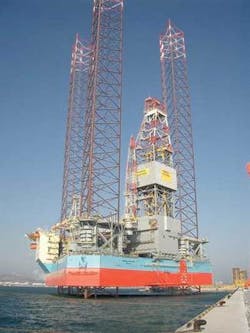Dual-role on Volve for harsh environment jackup
Maersk rig in line for 10-year contract
This December, the jackupMaersk Inspirer is scheduled to sail from Haugesund in western Norway to Statoil’s Volve field in North Sea block 15/9. On arrival, it should immediately start drilling and completing the first cluster of development wells, before switching in spring to a production role on the field, via the process module on its main deck.
The MSC CJ-70-designed rig is claimed to be the world’s largest ultra-harsh environment jackup. According to designers GustoMSC, it was also the only available unit of its type capable of operating in production mode in Volve’s 90-m water depth and harsh conditions.
Originally, Statoil was thought to have considered re-deploying an FPSO from its Glitne field, but Glitne continued producing longer than expected. The PGS/Bluewater consortium also offered a floater for Volve, but in December 2004, Statoil accepted Maersk Contractors’ ‘all-in-one’ solution.
Volve, a 70 MMbbl Triassic/Jurassic oilfield with 1.5 bcm of associated gas, will be developed in the first instance via eight platform-drilled wells - three producers, three water injectors and two for produced water disposal. Eventually, the number of wells could be increased to 15 and the wellhead module has been adapted accordingly.
According to GustoMSC’s Jos van der Hoorn, the jackup’s X-Y cantilever system also can be employed at any time during production for work-over or other intervention duties.
The field’s oil will flow through an oil export riser and 2-km subsea flexible pipeline to a dedicated floating storage unit, with the gas sent through a gas export riser and a 5-km pipeline to the Sleipner A platform. The rig is contracted to work on Volve for a minimum of three years, but if production meets expectations, the stay could be extended to a decade.
Main production equipment will comprise a process and power module on the main deck; a wellhead module equipped to handle 15 conductors fitted to the transom; and a flare tower positioned at the top of the starboard aft leg. Vetco Aibel in Oslo is supplying this equipment, but integration into the existing design is being managed jointly by GustoMSC, Vetco Aibel, and Maersk Contractors.
The fact that space is available on the main deck for the modules is due to the X-Y cantilever’s large transverse skidding capability (up to 30-ft portside as well as starboard). When skidded completely to one side of the rig, this creates a free area of around 20 x 60 m on the starboard side.
According to van der Hoorn, the dual role had been anticipated during original design of the CJ-70 class rigs. But the work on Volve still necessitated local modifications to the hull structure. In particular, the transom had to be strengthened to withstand combined loading of the cantilever with hook load, setback, and BOP tensioning; the wellhead module with the conductor tension; and the heavily cantilevered process module.
The process and power module and supporting structure will add 5,000 tons of weight to the main deck. The sub-structure comprises 10 support ‘stools’, designed to transfer the concentrated loads to the bulkheads below the main deck. GustoMSC is responsible for optimizing reinforcements to the bulkheads, the aim being to minimize labor inside the hull.
Despite the increased deck load, the verification process, performed by DNV, confirmed that there was sufficient strength in the hull, the leg-hull interface structures, and the legs to comply with specifications for Norwegian sector production platforms. Therefore, no further reinforcement work was necessary.
The topsides, fabricated by Vetco Aibel’s yard in Mapthaput, Thailand, were due to be transported in August to the same company’s yard in Haugesund, for loading onto the jackup this fall.

